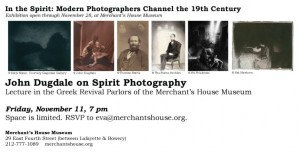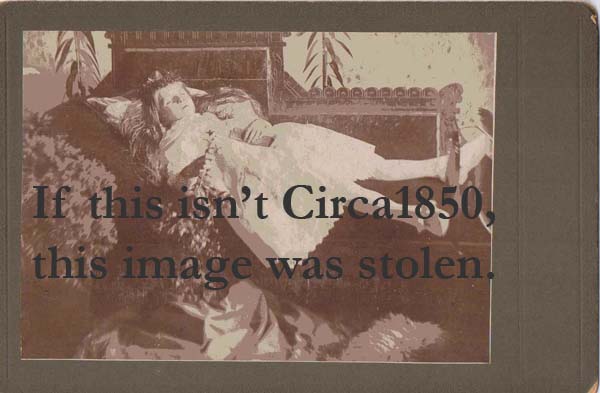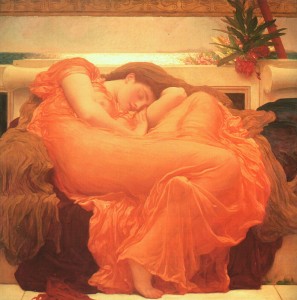Over the Bridge
July 20th, 2012
Forgive the lack of sewing updates — I’ve been working, but nothing quite ready to show off yet — and my excuse this week is Bridge. In addition to my regular two games, I’m sitting in on a third this afternoon.
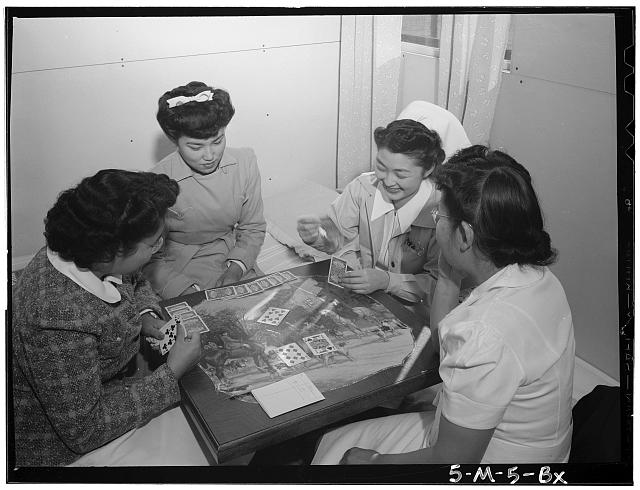
I only wish Ansel Adams (who took this marvelous photograph at a California recreation center in 1943) was going to be there today. Actually, I’ve heard that Adams was a frequent visitor to this area back in the 1930s, when he’d tramp around the dunes looking for things to shoot.
Looking more closely at the picture, I hope their bid wasn’t too high. They’ve only won 7 tricks, with two left to go. And the lady who has just led looks rather pleased with herself…
Salt Prints
November 25th, 2011
The Museum where I work (and sometimes curate exhibits that include modern art) has featured photographs by artist Hal Hirshorn in three exhibitions: “Tending the Fires”, “Memento Mori: The Birth & Resurrection of Postmortem Photography”, and “In the Spirit: Modern Photographers Channel the 19th Century”. Working with an early 20th-century view camera fitted with a mid-19th century lens, Hirshorn uses 19th-century techniques, including Henry Fox Talbot’s salt printing process, invented in 1834.
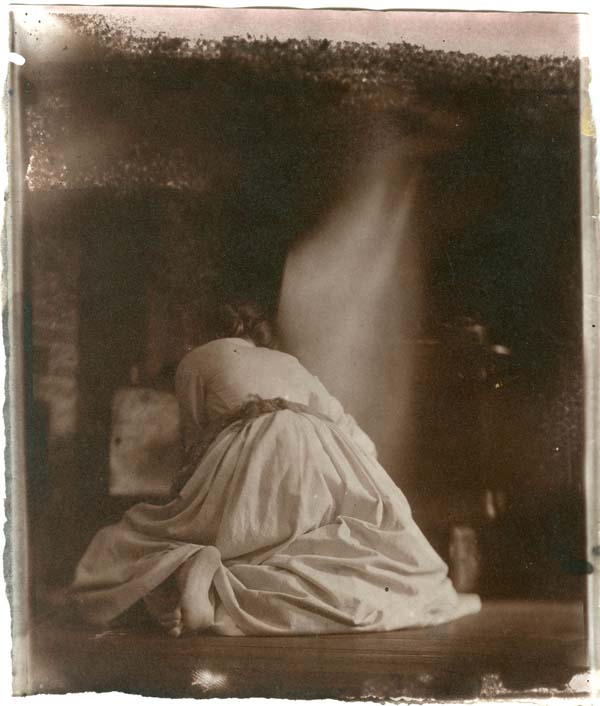
This salt print is from Hirshorn’s series shown in “Tending the Fires.” It was taken two years ago in the kitchen of the Merchant’s House Museum. Others featured the same model — representing one of the Irish servants who once lived and worked in the house — cleaning the parlor grates. One of those photographs was published in the Historic House Trust newsletter, where a visiting historian saw it and marveled at how lucky the museum was to have original period photographs of its servants…
It was a natural mistake, given the atemporality of the image, though it is extremely uncommon to find photographs of servants dressed in their working clothes from the mid-19th century — even more rare to see one in the act of cleaning. I was particularly amused because I was the model portraying the servant. I made the dress I wore in less than three days, then sweated through an August heat wave in a corset and three petticoats while holding really, really still for the long exposures. Before the shoot, Hal brought over books of photographs by Arthur Munby, a British photographer who broke with his own social class to document 19th-century working women — most famously taking many photographs of Hannah Cullwick, a maid-of-all-work who was also secretly married to Munby.
Earlier this year, I — and lots of other people — participated in another series by Hal Hirshorn, this time recreating the death and funeral of Seabury Tredwell in 1865.
It was an incredible project, a production of prodigious proportions. Hirshorn shot in three historic locations, including the Merchant’s House Museum, Grace Church, and the New York City Marble Cemetery. There were 14 different models — some taking part in multiple shoots — each wearing some sort of mid-19th century mourning costume. The weather was less than cooperative. The final shoots had to be rescheduled thanks to hurricane Irene. An earlier shoot took place despite an impending rainstorm that let loose just as we were heading home. You haven’t lived until you’ve chased four men in top hats carrying a coffin down Broadway, while wearing a corset and a hoop skirt, in the middle of a torrential downpour.
If you’d like to see the funeral photographs in person, you’ve got three more days, until Monday, November 28, to visit the exhibit at the Merchant’s House Museum. Works by Sally Mann, John Dudgale, and RA Friedman are also on display, along with historic spirit photographs from Thomas Harris and The Burns Archive.
John Dugdale on Spirit Photography
November 2nd, 2011
The art event of the season!
Click on the invite graphic to enlarge, or visit merchantshouse.org/spiritphotography for more information about the exhibit.
A Wake
October 7th, 2011
Earlier this week, I had reason to rout about in my shelf of photographs. Among the color slides from my husband’s trip to Mexico (circa 1964) and endless albums of wedding pictures, I came across a largish manilla envelope I’d stashed and promptly forgotten. It turned out to be four early 20th century postmortem photographs from my father’s side of the family along with a letter from my Auntie Mary (also my godmother). She sent the packet last year while I was curating Memento Mori: the Birth & Resurrection of Postmortem Photography.
I know that the idea of photographing the dead seems strange today, and even makes some people very uncomfortable. The reactions to the show last year were across the map, but they were all very emotional — which is exactly what a curator wants! A major component of Memento Mori was the amazing collection of The Burns Archive, which celebrated the release of Sleeping Beauty III in conjunction with the exhibition.
In the 19th century, when photography itself was relatively new and fairly expensive, the postmortem photograph was often the only image made of a person, especially in the case of childhood deaths. In their anxiety to have a picture, any picture, to remember their loved one by, bereaved families relied on the miracle of the camera. Photographers charged a premium to transport their cumbersome equipment and dangerous chemicals to the home of the deceased. Sometimes they worked to make the corpse seem as life-like as possible, posing it in a bed, or painting the eyes open once the plate was developed. In other cases, the body was photographed in a coffin, surrounded by candles and flowers. Before photographs, hiring an artist to make a painting or sculpture (or death mask) was the only way to make a portrait. Photography democratized personal memorials.
These are the four postmortem photographs that Auntie Mary sent. They are unidentified, but we know they belonged to our family, and were likely of family members. Postmortem photographs were extremely personal mementos, and are rarely labeled.
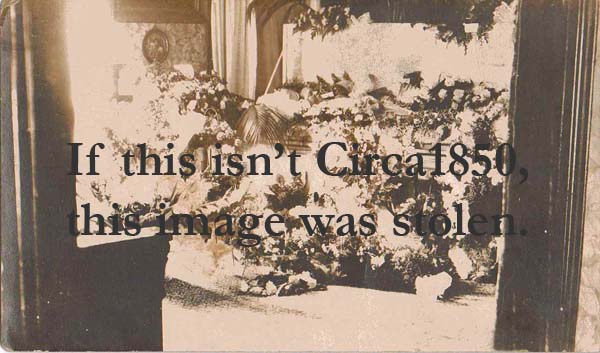
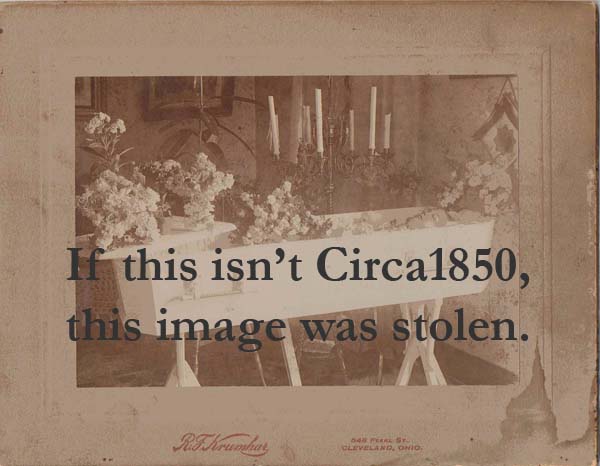
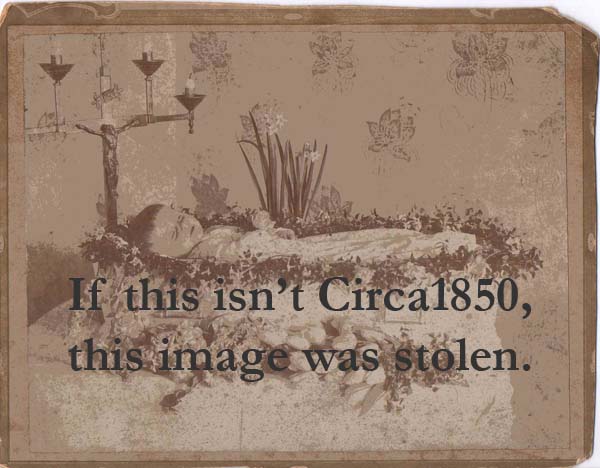
You’re probably wondering why I took the trouble to tag these photos with a snarky message. Normally I don’t care who borrows the photos I post (just don’t link back to the copy on my server please) but these seemed a little different. First of all, I know there is a demand for postmortem photographs. People are fascinated by them, and there just aren’t that many available; I know these will attract some attention. They’re also very precious to me. I want to share them with you, but I also want to make sure that people searching for images online think twice about reusing them.
Whew!
August 31st, 2011
What a week. And it’s only Tuesday…
I feel just like this painting (Flaming June, by Lord Frederic Leighton) looks — warm and sleepy and ready to curl up on a divan somewhere.
As you may have gathered from recent posts, I’ve lately been helping to arrange a monumental series of photo shoots for artist Hal Hirshorn (which will be shown in an upcoming exhibit that I am curating). The final shoot was today, in the New York City Marble Cemetery. Here’s a sneak peak, as posted on an East Village blog, with snapshots taken by some folks who just happened to be wandering past while Hal was shooting.
Then tonight, after standing around all day in the hot sun, wearing 19th-century mourning clothes, I ran over to the Hudson Park Library to supervise a lecture about the restoration going on at the Merchant’s House Museum, given by one of the City’s architectural conservators.
Last evening, we had a meeting of the New York Nineteenth Century Society. Everyone was encouraged to bring something to show and tell, so I dragged my cello to Madame X (our de facto clubhouse) and led everyone in singing “I Dreamt I Dwelt in Marble Halls.” It was a grand moment, despite my very limited musicianship. Other impressive offerings included Cherry Bounce, a Bartitsu demonstration, an embroidered Regency gown, a Victorian inspired jacket, a Puccini aria, to name a few.
I made this a while ago, and am sharing it now to give you an idea of what you missed. Picture 15 slightly tipsy people singing along in the back garden of a “vampire bordello” themed SoHo bar…
Let’s see, what else? I’ve nearly finished my crocheted edging. And I’ve starting hand-sewing the tucked petticoat to which it will soon be attached. I recently finished The Mayor of Casterbridge, and am now working on The Last Chronicle of Barset. Not sure what I’ll pick up next, but a good friend assures me that Jude the Obscure is among Hardy’s best, and by far the most depressing. Which is really saying something, if you ask me!
Well I think that’s about it, at least for things that would be likely to interest you. Hopefully I’ll settle back into a normal routine soon, and start sharing some less frenetic posts.
Older Posts »




